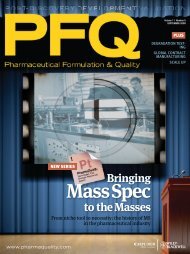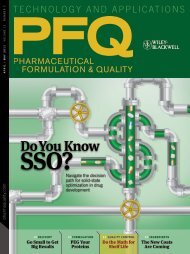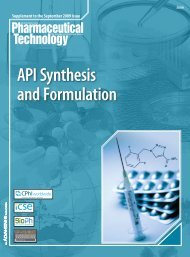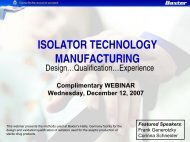Practical Technologies for Lyophilization - Sterile Parenteral Drug ...
Practical Technologies for Lyophilization - Sterile Parenteral Drug ...
Practical Technologies for Lyophilization - Sterile Parenteral Drug ...
You also want an ePaper? Increase the reach of your titles
YUMPU automatically turns print PDFs into web optimized ePapers that Google loves.
equipment to pharmaceutical and<br />
biotechnology companies <strong>for</strong> their <strong>for</strong>mulations<br />
work and process development<br />
of parenteral products. “Our<br />
Smart Freeze-Dryer calculates product<br />
temperature and makes adjustments in<br />
the process to keep product frozen<br />
throughout the cycle. Smart freezedrying<br />
technology uses the data from<br />
manometric pressure rise measurement<br />
in its proprietary algorithms to accurately<br />
calculate product temperature at<br />
the ice surface interface of the product.<br />
“Smart Freeze Dryer equipment has<br />
an isolation valve between the product<br />
and condenser chamber. This valve closes<br />
<strong>for</strong> 25 seconds and the system measures<br />
pressure at the valve junction; 250<br />
pressure readings are used to calculate<br />
product temperature. SMART then<br />
makes automatic adjustments in chamber<br />
pressure and shelf setpoint temperature<br />
to quickly bring the product temperature<br />
to a safety margin just below<br />
its collapse temperature. Since freezedrying<br />
cycles can be long, ranging anywhere<br />
from six hours to one week, the<br />
Smart system can save money by eliminating<br />
the trial-and-error approach to<br />
cycle design,” explains Mather.<br />
Process Analytical Technology<br />
PAT is based on the premise that quality<br />
assurance should be built-in or<br />
designed as part of the product. It<br />
emphasizes a process-driven approach<br />
vs. the more traditional data-validated<br />
approach. “The goal of PAT is to specify,<br />
monitor, and control processes to consistently<br />
ensure a pre-defined product quality,”<br />
states Jos Corver, senior scientist at<br />
BOC Edwards (www.bocedwards.com).<br />
PAT is emphasized by FDA <strong>for</strong> two<br />
reasons: the old-fashioned time-consuming<br />
data-oriented approach did not guarantee<br />
a flawless process or product quality<br />
and the release of new medical drugs<br />
was delayed by the time-consuming<br />
review of required data, which motivated<br />
the FDA to promote new technologies<br />
that increase the quality of monitoring<br />
data, leading to better process control.<br />
“PAT can be quite powerful as understanding<br />
the science behind a given technology<br />
is its main focus. Knowing what<br />
you are doing, understanding important<br />
parameters, and applying science to<br />
control and improve process can highly<br />
improve product quality,” says Corver.<br />
NMR-based Noncontact<br />
Weighing Technology<br />
Devising a well-controlled and predictable<br />
process requires accurate measurement<br />
of critical parameters, one of<br />
these being IPC (in-process control) of the<br />
filling system. Traditional balances rely on<br />
data derived from sampling vials taken<br />
out from the actual process and are subject<br />
to vagaries such as vibration, air-flow,<br />
and pressure fluctuations.<br />
BOC Edwards has devised a noninvasive<br />
NMR-based, in-line, noncontact<br />
check-weighing (NCCW) technology.<br />
This system determines the weight of<br />
the contents of a vial with a single measurement,<br />
without taking the vial out of<br />
the transport system and without making<br />
physical contact with the vial. Since<br />
the response to an electromagnetic pulse<br />
is linearly proportional to the amount of<br />
product, a relatively simple calibration<br />
procedure is sufficient to apply this technology<br />
as a balance.<br />
“It is critical that the amount of product<br />
in pharmaceutical drug vials is guaranteed<br />
within the label claim. Measurement<br />
of the contents of each individual<br />
vial is there<strong>for</strong>e an important aspect.<br />
Vials are typically overfilled to meet the<br />
stated claim. This NMR technique can<br />
be applied to liquid and solids. Having a<br />
system that gives feedback to filling stations<br />
at 100% rate allows <strong>for</strong> good<br />
process control. One can there<strong>for</strong>e produce<br />
at lower volume vials due to the<br />
narrower band fill and accuracy of the<br />
technology. Wastage due to overfilling<br />
can be avoided resulting in time and<br />
cost savings,” says Dr. Corver.<br />
Biopharma Technology (BTL; www.<br />
lyophilizationtechnology.com) markets a<br />
Lyostat 2 freeze-drying microscope and a<br />
Lyotherm 2 thermal analyzer. The Lyostat<br />
2 Freeze Drying Microscope System<br />
enables identification of collapse and<br />
eutectic (freezing point) temperatures. In<br />
the Lyostat 2 system, an in-built stage<br />
chamber acts as a micro freeze-dryer. A<br />
small product sample is loaded onto a temperature-controlled<br />
block and subjected to<br />
freezing at a selected rate and observed<br />
while drying at a range of temperatures in<br />
order to determine its critical temperature(s).<br />
This process can be viewed in realtime<br />
either through the microscope or on a<br />
PC with image-capture software.<br />
Microscope and Thermal<br />
Impedance<br />
The Lyotherm 2 thermal analyzer<br />
enables one to per<strong>for</strong>m differential thermal<br />
analysis (DTA) and electrical impedance<br />
measurement at the same time. This<br />
is an alternative low-cost technology<br />
compared to the Differential Scanning<br />
Calorimeter (DSC). The DTA allows<br />
determination of glass transition (Tg),<br />
eutectic (Teu) temperatures and crystallization<br />
events, while the data obtained<br />
from impedance analysis (Zsinϕ)—a<br />
method that is based on conventional<br />
resistance technology (as used in socalled<br />
eutectic monitors), but that has<br />
been demonstrated to be more sensitive<br />
to changes in frozen solutes—can be correlated<br />
to critical mobility-related events<br />
occurring in the frozen material.<br />
The in<strong>for</strong>mation gained from Lyostat<br />
2 and Lyotherm 2 enables <strong>for</strong>mulations<br />
to be refined according to behavior and<br />
November 15, 2006 genengnews.com Genetic Engineering & Biotechnology News






